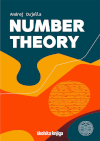- About MAA
- Membership
- MAA Publications
- Periodicals
- Blogs
- MAA Book Series
- MAA Press (an imprint of the AMS)
- MAA Notes
- MAA Reviews
- Mathematical Communication
- Information for Libraries
- Author Resources
- Advertise with MAA
- Meetings
- Competitions
- Programs
- Communities
- MAA Sections
- SIGMAA
- MAA Connect
- Students
- MAA Awards
- Awards Booklets
- Writing Awards
- Teaching Awards
- Service Awards
- Research Awards
- Lecture Awards
- Putnam Competition Individual and Team Winners
- D. E. Shaw Group AMC 8 Awards & Certificates
- Maryam Mirzakhani AMC 10 A Awards & Certificates
- Two Sigma AMC 10 B Awards & Certificates
- Jane Street AMC 12 A Awards & Certificates
- Akamai AMC 12 B Awards & Certificates
- High School Teachers
- News
You are here
Number Theory

Publisher:
Školska knjiga
Publication Date:
2021
Number of Pages:
636
Format:
Hardcover
Price:
48.00
ISBN:
978-9530308978
Category:
Textbook
[Reviewed by , on ]
Caleb McWhorter
12/27/2021
It has been said many a time, by many a mathematician, that number theory is the "Queen" or "gem" of Mathematics. But if this is indeed true, then that gem lies at the bottom of an expansive ocean. Andrej Dujella's Number Theory dares to charter students across these waters known not only for their beauty but also their tempests. Based on teaching materials from the author's courses at the University of Zagreb, the book is wonderfully translated from its original Croatian—no fumbling to be found. Moreover, and in contrast to many books of its kind, the book lies beautifully on the page. Spanning sixteen chapters and 621 pages, the book covers divisibility, congruences, quadratic residues and forms, arithmetic functions, the distribution of primes, Diophantine equations and approximations, polynomial divisibility, algebraic numbers, elliptic curves, and a scattering of other topics throughout.
The book's target audience is university mathematics students, broadly speaking, and the materials have been apparently successfully implemented in undergraduate and graduate courses. While there is no stated background required for undergraduates using the book, it might be summarized as a certain level of mathematical maturity. For instance, big-O notation appears without discussion, knowledge of calculus is at times unexpectedly assumed, familiarity with summations and binomial coefficients are taken for granted, and terse backgrounds are given for topics that some undergraduate students may find difficult. This could be problematic for some instructors using this as a course textbook. Indeed, any common introductory topics for such a course, e.g. sets, proof techniques, induction, etc., only occupy ten pages while the entirety of a "typical" elementary number theory course, e.g. divisibility, congruences, quadratic residues, primitive roots, Legendre and Jacobi symbols, etc., only occupies slightly over one hundred pages of the book. The book also lacks nearly any of the details, photos, etc. on mathematicians or the history of mathematics that one tends to include in such courses. At times, theorems can wander from the discussion required to prove them, and the proofs can skip steps that would be routine for stronger students but difficult for weaker students. However, many of these "shortcomings" are easily surmounted by supplementing the text with additional reading materials. In fact, where many instructors find themselves supplementing other texts, this book wonderfully provides. For instance, the text never fails to discuss algorithm implementation—with pseudocode—and algorithmic complexity. There are also excellent resources available on the author's webpage to guide the usage of the book in an undergraduate or graduate course.
While some of these issues present clear challenges to instructors wishing to use the book for a course in elementary number theory or a first "upper level" course in mathematics for certain students, it is a strong selling point for others. The book presents an appropriately challenging, focused read that covers a large swath of topics. This makes the book very useful for a more advanced undergraduate number theory course, a department having several undergraduate number theory offerings, or a two-sequence course in number theory. The level of simultaneous breadth and depth offered in this book simply cannot be found in other standard texts like Burton's Elementary Number Theory, Barnett's Elements of Number Theory, or Adler and Coury's The Theory of Numbers. For a similar treatment of the expansiveness of number theory, one would have to turn to Ireland and Rosen's A Classical Introduction to Modern Number Theory, which would not be appropriate for many undergraduate audiences. This book could also be perfectly used in a single semester graduate course in number theory wishing to give students a "birds eye view" of number theory to direct their interests. Wonderfully for both audiences, the book contains plenty of recent results to capture the reader's attention and give a flavor for modern research. Although not overly abundant, the exercises are not guilty of superfluous repetition and are instead focused on pushing the essentials for each topic. Many chapters address open problems that an instructor could assign students to examine. Above all, Number Theory does a masterful job at capturing the subtle and graceful intertwining of the analytic, the algebraic, and the combinatorial with more traditional elementary number theory.
Dr. Caleb McWhorter is an Assistant Professor of Mathematics at St. Thomas Aquinas College. His research is in number theory, primarily in arithmetic geometry focused on elliptic curves.
See the publisher's website.
- Log in to post comments




